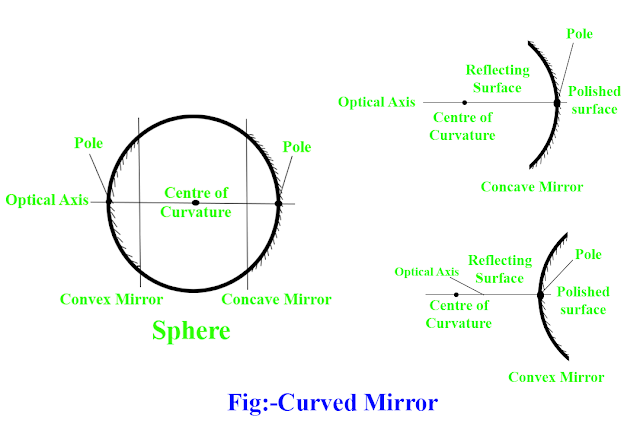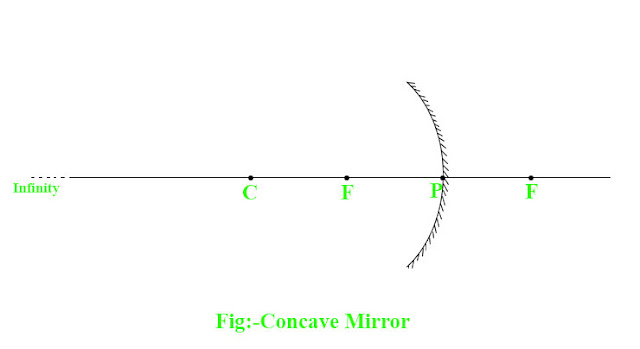Introduction
In Curved mirror Qsolution's post you are going to learn:-
- About curved mirror
- About important terms of curved mirror
- Types of spherical mirror
- Parabolic mirror
- Uses of curved mirror
- Difference between concave and convex mirror
Curved Mirror
A mirror having curved reflecting surface either bulged outside and recessed inward is known as curved mirror. Most of the curved mirrors are parts of the sphere. Hence curved mirror which is a part of sphere has also known as spherical mirror. But sometimes other non-spherical shapes are used in optical devices like parabolic reflectors. such type of curved mirror has called parabolic mirror. The systematic diagram of spherical curved mirror is shown below:-
When a hollow sphere of required size and thickness has cut into pieces as shown in above figure. Then the curved shaped pieces of sphere of desired size has obtained. When the outer surface of the curved shaped piece of sphere has polished and inner surface has made reflecting surface, then a curved mirror has formed called concave mirror. Concave mirror has depressed inward at middle on the reflecting surface.
When the inner surface of the curved shaped piece of sphere has polished and outer surface has made reflecting surface, then a curved mirror has formed called convex mirror. Convex mirror has bulged outside at middle on the reflecting surface.
Important Terms of Curved Mirror
1)Pole
The center of spherical reflecting surface of the mirror has called the pole. It has denoted by P as shown in above given figure.
2)Centre of curvature
The centre of the sphere of which the mirror is a part has called the centre of curvature. It has denoted by C as shown in above given figure.
3)Radius of curvature
The radius of the sphere of which the mirror is a part has called the radius of curvature. It has denoted by R as shown in above given figure.
4)Principal Axis
A line which has drawn through the pole of the mirror and the centre of curvature has called principal axis. It has shown in the above given figure.
5)Principal Focus
In the case of concave mirror, principle focus is the point at which all the parallel rays close to the principal axis converge after the reflection. In the case of convex mirror, principle focus is the point at which all parallel rays close to the principal axis appear to diverge from it after reflection. It has also called the focal point. It has denoted by F as shown in above given figure.
6)Focal plane
A plane which is perpendicular to the principal axis and passes through the focal point has called focal plane. It is the plane where rays of light parallel with each-others but not parallel with the principal axis converge at or appear to diverge from it after reflection. It has shown in above given figure.
7)Focal length
The distance between the pole of the mirror and its principal focus has called focal length. Focal length of concave mirror is positive, while that of convex mirror is negative. It is denoted by small f as shown in above given figure.
8)Aperture
The diameter of the boundary of the mirror is called aperture. XY is the aperture in above given figure.
Types of Spherical Mirror
Spherical mirrors are the mirrors having curved surfaces which are painted on one of the sides. Spherical mirror has classified into two types which are listed below:-
1)Concave Mirror
Concave mirror is a spherical curved mirror in which reflection takes place in the inner surface of the sphere of which the mirror is a part. Concave mirror has depressed inward at middle on the reflecting surface. Outer surface of the concave mirror has painted as shown in figure below:-
Concave mirror converges incomming the rays of light when they strike on the reflecting surface of the mirror. Hence, it is also known as the converging mirror. When an object is very close to the convex mirror less than focal length of mirror, a magnified and virtual image has obtained. But if the distance between mirror and object increases, the size of image reduces and a real image has formed.
2)Convex Mirror
Convex mirror is a spherical curved mirror in which reflection takes place in the outer surface of the sphere of which the mirror is a part. Convex mirror has bulged outside at middle on the reflecting surface. It has Painted on inner surface as shown in figure below:-
Convex mirror diverges the incomming rays of light when they strike on the reflecting surface of the mirror. Hence, it has also known as the diverging mirror. Generally, image formed by convex mirror is virtual, errect and diminished in size.
Parabolic Mirror
Sometimes non-spherical shaped curved mirror is used in optical devices to get perfectly parallel beam of light after reflection has called parabolic mirror. Parabolic mirrors have slighty different shape from the spherical mirror so that they will give perfectly parallel beam of light when light source is at the focus. The systematic diagram of parabolic mirror are shown in the given figure below:-
Parabolic mirror has used behind the bulb in a big lamp, large searchlight or projector to give preflectly parallel beam of light. They have also used in big reflecting telescopes because they give much sharper images than the spherical mirrors.
Uses of Spherical Mirror
Spherical mirrors have been using for various purpose in the modern world which have listed below:-
1)Uses of Concave Mirror
- Concave mirror has used in torchlight, automobile headlamps, lighthouses etc to reflect the light and make fine beam of light.
- Concave mirror has used in aircraft landing at the airports to guide the airplane during landing.
- It has used as the shaving mirror to get enlarge and erect image of the face.
- Concave mirrors have also used in the solar ovens. They collect a large amount of solar energy and to focus at a point where vessel has placed.
- Concave mirrors have also used by dentists and ENT doctors to obtain larger image.
- It has used in satellite dishe, electronic microscope, astronomical telescopes, visual bomb detectors etc.
2)Uses of Convex Mirror
- Convex mirrors have used as a side-view/rear-view mirror in vehicles. Because it forms an erect and smaller image of traffic behind.
- It is suitable in convenient shops, big supermarkets and any other corner for a wide observation.
- Convex mirrors can be use as street light reflectors inorder to spread the light over a large area.
- They have put the corners of the roads to see any vehicles and avoid collisions by taking due measures.
Difference Between Concave and Convex Mirror
| S.N | Concave Mirror | Convex Mirror |
| 1) | It has outer surface polished and inner surface has made reflecting surface. | It has inner surface polished and outer surface has made reflecting surface. |
| 2) | It forms real, inverted and enlarged image of an onject (except when an object has placed between P and F where the image is virtual, erect and enlarged). | It forms virtual, erect and diminished image of an object. |
| 3) | It has also known as converging mirror because it converges the incomming rays of the light. | It has also known as diverging mirror because it diverges the incomming rays of the light. |
| 4) | It has depressed inward at middle on the reflecting surface. | It has bulged outside at middle on the reflecting surface. |
| 5) | It's focus and centre of curvature lies infornt of the mirror. | Its focus and centre of curvature lies behind the mirror. |
| 6) | It's image can be obtained on the screen as it is real. | It's image cannot be obtained on the mirror as it is virtual. |
| 7) | It's focal length is positive as focus lies infornt of the mirror. | It's focal length is negative as focus lies behind the mirror. |
| 8) | It's image size depends upon the position of object. | It always forms smaller image than the object. |
| 9) | It's image position depends on the position of object. | It always forms image within the focus, irrespective of the position of the object. |
| 10) | It's magnification can be greater, equal or less than 1. | It's magnification is always less than one |
| 11) | It has used in reflecting telescopes, shaving mirrors, torchlights, etc. as they give a magnified image of the objects. | It has used as the side-view or rear-view mirrors in vehicles, optical instruments, calling bells etc, as it covers a wider area of view of traffic behind. |









No comments: